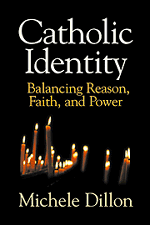Book contents
- Frontmatter
- Contents
- Acknowledgments
- 1 Pro-Change Catholics: Forging Community out of Diversity
- 2 Doctrinal Change in the Catholic Church
- 3 Official Church Teaching on Homosexuality, Women's Ordination, Abortion, and the Role of the Theologian
- 4 Pro-Change Groups in the Contemporary Church: Dignity, the Women's Ordination Conference, and Catholics for a Free Choice
- 5 Gay and Lesbian Catholics: “Owning the Identity Differently”
- 6 Using Doctrine to Critique Doctrine
- 7 Pluralism in Community
- 8 Reasoned Theology: Legitimating Emancipatory Possibilities
- 9 Catholic Options
- Appendix: Research Methodology
- References
- Index
4 - Pro-Change Groups in the Contemporary Church: Dignity, the Women's Ordination Conference, and Catholics for a Free Choice
Published online by Cambridge University Press: 04 August 2010
- Frontmatter
- Contents
- Acknowledgments
- 1 Pro-Change Catholics: Forging Community out of Diversity
- 2 Doctrinal Change in the Catholic Church
- 3 Official Church Teaching on Homosexuality, Women's Ordination, Abortion, and the Role of the Theologian
- 4 Pro-Change Groups in the Contemporary Church: Dignity, the Women's Ordination Conference, and Catholics for a Free Choice
- 5 Gay and Lesbian Catholics: “Owning the Identity Differently”
- 6 Using Doctrine to Critique Doctrine
- 7 Pluralism in Community
- 8 Reasoned Theology: Legitimating Emancipatory Possibilities
- 9 Catholic Options
- Appendix: Research Methodology
- References
- Index
Summary
Support for lay autonomy in the church has historically been a prominent feature of American Catholicism. In continuity with the pluralistic tradition set in place by colonial Catholicism and expanded during the republican period (1780–1820), nineteenth-century American Catholicism emphasized a democratic approach to church governance, stressed the values of religious freedom and intelligibility, and argued for a vernacular liturgy (Dolan 1985: 111; see also Ahlstrom 1972: 330–335, 540–547). Thus in the mid-nineteenth century several immigrant communities fought over whether to establish a European monarchical or an American democratic model of the church. These rifts continued into the twentieth century and during the pre–World War II period contributed to the split of hundreds of thousands of East European immigrants from what they regarded as an overly controlling hierarchical church (Dolan 1985: 184–189). Systematic attempts by the Vatican to restrain democratic tendencies and to uphold the primacy of the church hierarchy's authority were especially evident with Vatican I (1869–1870) and the Vatican's subsequent condemnation of Americanism (Leo XIII, 1899) and Modernism (Pius X, 1907). Nonetheless, the tension between the church hierarchy's authority and personal autonomy was a continuing, if at times subdued, feature of American Catholicism from the late nineteenth century until Vatican II, when it became more public and pronounced (Seidler and Meyer 1989; Vaillancourt 1980).
OVERVIEW OF POST–VATICAN II CATHOLIC ATTITUDES
The post–Vatican II period witnessed a broad-based and qualitative shift in American Catholics' disposition toward the church hierarchy's authority over faith and (sexual) morals.
- Type
- Chapter
- Information
- Catholic IdentityBalancing Reason, Faith, and Power, pp. 77 - 114Publisher: Cambridge University PressPrint publication year: 1999



